Traditional honey pot from North Korea
Honey bees form nectar into honey by a process of regurgitation and store it as a primary food source in wax honeycombs inside the beehive. Beekeeping practices encourage overproduction of honey so that the excess can be taken without endangering the bee colony.
Honey gets its sweetness from the monosaccharides fructose and glucose and has approximately the same relative sweetness as that of granulated sugar.[1][2] It has attractive chemical properties for baking, and a distinctive flavor that leads some people to prefer it over sugar and other sweeteners.[1] Most microorganisms do not grow in honey because of its low water activity of 0.6.[3] However, honey sometimes contains dormant endospores of the bacterium Clostridium botulinum, which can be dangerous to infants as the endospores can transform into toxin-producing bacteria in the infant's immature intestinal tract, leading to illness and even death[4] (see Health hazards below).
Honey has a long history of human consumption and is used in various foods and beverages as a sweetener and flavoring. It also has a role in religion and symbolism. Flavors of honey vary based on the nectar source, and various types and grades of honey are available. It is also used in various medicinal traditions to treat ailments. The study of pollens and spores in raw honey (melissopalynology) can determine floral sources of honey.[5] Because bees carry an electrostatic charge, and can attract other particles, the same techniques of melissopalynology can be used in area environmental studies of radioactive particles, dust or particulate pollution.[6][7]
Contents |
Formation
Honey is created by bees as a food source. In cold weather or when fresh food sources are scarce, bees use their stored honey as their source of energy.[8] By contriving for bee swarms to nest in artificial hives, people have been able to semi-domesticate the insects, and harvest excess honey. In the hive (or in a wild nest) there are three types of bee: a single female queen bee, a seasonally variable number of male drone bees to fertilize new queens, and some 20,000 to 40,000 female worker bees.[9] The worker bees raise larvae and collect the nectar that will become honey in the hive. Leaving the hive, they collect sugar-rich flower nectar and return.In the hive the bees use their "honey stomachs" to ingest and regurgitate the nectar a number of times until it is partially digested.[10] The bees work together as a group with the regurgitation and digestion until the product reaches a desired quality. It is then stored in honeycomb cells. After the final regurgitation, the honeycomb is left unsealed. However, the nectar is still high in both water content and natural yeasts, which, unchecked, would cause the sugars in the nectar to ferment.[8] The process continues as bees inside the hive fan their wings, creating a strong draft across the honeycomb, which enhances evaporation of much of the water from the nectar.[8] This reduction in water content raises the sugar concentration and prevents fermentation. Ripe honey, as removed from the hive by a beekeeper, has a long shelf life and will not ferment if properly sealed.[8]
In history, culture, and folklore
Honey use and production has a long and varied history. In many cultures, honey has associations that go beyond its use as a food. Honey is frequently used as a talisman and symbol of sweetness.[citation needed]Ancient times
Honey collection is an ancient activity. Eva Crane's The Archaeology of Beekeeping states that humans began hunting for honey at least 10,000 years ago.[11] She evidences this with a cave painting in Valencia, Spain. The painting is a Mesolithic rock painting, showing two female honey-hunters collecting honey and honeycomb from a wild bee nest. The two women are depicted in the nude, carrying baskets, and using a long wobbly ladder in order to reach the wild nest.In ancient Egypt, honey was used to sweeten cakes and biscuits, and was used in many other dishes. Ancient Egyptian and Middle Eastern peoples also used honey for embalming the dead.[12] Pliny the Elder devotes considerable space in his book Naturalis Historia to the bee and honey, and its many uses. The fertility god of Egypt, Min, was offered honey.[13]
The art of beekeeping appeared in ancient China for a long time and hardly traceable to its origin. In the book "Golden Rules of Business Success" written by Fan Li (or Tao Zhu Gong) during the Spring and Autumn Period, there are some parts mentioning the art of beekeeping and the importance of the quality of the wooden box for bee keeping that can affect the quality of its honey.
Honey was also cultivated in ancient Mesoamerica. The Maya used honey from the stingless bee for culinary purposes and continue to do so today. The Maya also regard the bee as sacred (see Mayan stingless bees of Central America).
Some cultures believed honey had many practical health uses. It was used as an ointment for rashes and burns, and used to help soothe sore throats when no other medicinal practices were available.
Religious significance
In Hinduism, honey (Madhu) is one of the five elixirs of immortality (Panchamrita). In temples, honey is poured over the deities in a ritual called Madhu abhisheka. The Vedas and other ancient literature mention the use of honey as a great medicinal and health food.In Jewish tradition, honey is a symbol for the new year, Rosh Hashanah. At the traditional meal for that holiday, apple slices are dipped in honey and eaten to bring a sweet new year. Some Rosh Hashanah greetings show honey and an apple, symbolizing the feast. In some congregations, small straws of honey are given out to usher in the new year.
The Hebrew Bible contains many references to honey. In the Book of Judges, Samson found a swarm of bees and honey in the carcass of a lion (14:8). The Book of Exodus famously describes the Promised Land as a "land flowing with milk and honey" (33:3). However, the claim has been advanced that the original Hebrew (devash) actually refers to the sweet syrup produced from the juice of dates.[14][15] Pure honey is considered kosher even though it is produced by a flying insect, a non-kosher creature; other products of non-kosher animals are non-kosher.[16]
In Buddhism, honey plays an important role in the festival of Madhu Purnima, celebrated in India and Bangladesh. The day commemorates Buddha's making peace among his disciples by retreating into the wilderness. The legend has it that while he was there, a monkey brought him honey to eat. On Madhu Purnima, Buddhists remember this act by giving honey to monks. The monkey's gift is frequently depicted in Buddhist art.
In the Christian New Testament, Matthew 3:4, John the Baptist is said to have lived for a long period of time in the wilderness on a diet consisting of locusts and wild honey.
In Islam, there is an entire Surah in the Qur'an called al-Nahl (the Honey Bee). According to hadith, Prophet Muhammad strongly recommended honey for healing purposes.[17] Qur'an promotes honey as a nutritious and healthy food. Below is the English translation of those specific verses.
And your Lord inspired the bees, saying: "Take you habitations in the mountains and in the trees and in what they erect. (68) Then, eat of all fruits, and follow the ways of your Lord made easy (for you)." There comes forth from their bellies, a drink of varying colour wherein is healing for men. Verily, in this is indeed a sign for people who think.[18]
In Western culture
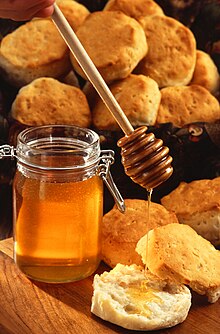
A jar of honey with honey dipper
Also, in many children’s books bears are depicted as eating honey, (e.g., Winnie the Pooh) even though most bears actually eat a wide variety of foods, and bears seen at beehives are usually more interested in bee larvae than honey.[19] In some European languages even the word for 'bear' (e.g. in Russian 'medvéd', in Czech 'medvěd, in Serbian 'medved', in Croatian 'medvjed') is coined from the noun meaning 'honey' and the verb meaning 'to eat'. Honey is sometimes sold in bear-shaped jars or squeeze bottles.
Modern uses
As a food and in cooking
The main uses of honey are in cooking, baking, as a spread on bread, and as an addition to various beverages such as tea and as a sweetener in some commercial beverages. According to international food regulations, "honey stipulates a pure product that does not allow for the addition of any other substance...this includes, but is not limited to, water or other sweeteners".[20] Honey barbecue and honey mustard are common and popular sauce flavors.Honey is the main ingredient in the alcoholic beverage mead, which is also known as "honey wine" or "honey beer". Historically, the ferment for mead was honey's naturally occurring yeast. Honey is also used as an adjunct in some beers.
Nutrition
| Nutritional value per 100 g (3.5 oz) | |
|---|---|
| Energy | 1,272 kJ (304 kcal) |
| Carbohydrates | 82.4 g |
| Sugars | 82.12 g |
| Dietary fiber | 0.2 g |
| Fat | 0 g |
| Protein | 0.3 g |
| Water | 17.10 g |
| Riboflavin (Vit. B2) | 0.038 mg (3%) |
| Niacin (Vit. B3) | 0.121 mg (1%) |
| Pantothenic acid (B5) | 0.068 mg (1%) |
| Vitamin B6 | 0.024 mg (2%) |
| Folate (Vit. B9) | 2 μg (1%) |
| Vitamin C | 0.5 mg (1%) |
| Calcium | 6 mg (1%) |
| Iron | 0.42 mg (3%) |
| Magnesium | 2 mg (1%) |
| Phosphorus | 4 mg (1%) |
| Potassium | 52 mg (1%) |
| Sodium | 4 mg (0%) |
| Zinc | 0.22 mg (2%) |
| Shown is for 100 g, roughly 5 tbsp. Percentages are relative to US recommendations for adults. Source: USDA Nutrient database | |
Typical honey analysis.[25]
- Fructose: 38.2%
- Glucose: 31.3%
- Sucrose: 1.3%
- Maltose: 7.1%
- Water: 17.2%
- Higher sugars: 1.5%
- Ash: 0.2%
- Other/undetermined: 3.2%
Honey has a density of about 1.36 kilograms per litre (36% denser than water).[27]
Isotope ratio mass spectrometry can be used to detect addition of corn syrup or sugar cane sugars by the carbon isotopic signature. Addition of sugars originating from corn or sugar cane (C4 plants, unlike the plants used by bees, which are predominantly C3 plants) skews the isotopic ratio of sugars present in honey, but does not influence the isotopic ratio of proteins; in an unadulterated honey the carbon isotopic ratios of sugars and proteins should match. As low as 7% level of addition can be detected.[28][dead link]
Classification
Honey is classified by its floral source, and there are also divisions according to the packaging and processing used. There are also regional honeys. Honey is also graded on its color and optical density by USDA standards, graded on a scale called the Pfund scale, which ranges from 0 for "water white" honey to more than 114 for "dark amber" honey.[29]Floral source
Generally, honey is classified by the floral source of the nectar from which it was made. Honeys can be from specific types of flower nectars, from indeterminate origin, or can be blended after collection.Blended
Most commercially available honey is blended, meaning that it is a mixture of two or more honeys differing in floral source, color, flavor, density or geographic origin.[30]Polyfloral
Polyfloral honey, also known as wildflower honey,[31] is derived from the nectar of many types of flowers.[32] The taste may vary from year to year, and the aroma and the flavor can be more or less intense, depending on which bloomings are prevalent.[33]Monofloral
Monofloral honey is made primarily from the nectar of one type of flower. Different monofloral honeys have a distinctive flavor and color because of differences between their principal nectar sources.[34] To produce monofloral honey, beekeepers keep beehives in an area where the bees have access to only one type of flower. In practice, because of the difficulties in containing bees, a small proportion of any honey will be from additional nectar from other flower types. Typical examples of North American monofloral honeys are clover, orange blossom, sage, tupelo, buckwheat, fireweed, and sourwood. Some typical European examples include thyme, thistle, heather, acacia, dandelion, sunflower, honeysuckle, and varieties from lime and chestnut trees. In North Africa, such as Egypt, examples include clover, cotton, and citrus (mainly orange blossoms).Honeydew honey
Instead of taking nectar, bees can take honeydew, the sweet secretions of aphids or other plant sap-sucking insects. Honeydew honey is very dark brown in color, with a rich fragrance of stewed fruit or fig jam and is not sweet like nectar honeys.[34] Germany's Black Forest is a well known source of honeydew-based honeys, as well as some regions in Bulgaria and Northern California in the United States. In Greece, pine honey (a type of honeydew honey) constitutes 60–65% of the annual honey production.[35] Honeydew honey is popular in some areas, but in other areas beekeepers have difficulty selling the stronger flavored product.The production of honeydew honey has some complications and dangers. The honey has a much larger proportion of indigestibles than light floral honeys, thus causing dysentery to the bees, resulting in the death of colonies in areas with cold winters. Good beekeeping management requires the removal of honeydew prior to winter in colder areas. Bees collecting this resource also have to be fed protein supplements, as honeydew lacks the protein-rich pollen accompaniment gathered from flowers.
Classification by packaging and processing
A variety of honey flavors and container sizes and styles from the 2008 Texas State Fair
- Crystallized honey is honey in which some of the glucose content has spontaneously crystallized from solution as the monohydrate. Also called "granulated honey." Honey that has crystallized over time (or commercially purchased crystallized) in the home can be returned to a liquid state if stirred in a container sitting in warm water at 120 °F (approx 49 °C).[36]
- Pasteurized honey is honey that has been heated in a pasteurization process. Pasteurization destroys yeast cells. It also liquefies any micro-crystals in the honey, which delays the onset of visible crystallization. However, excessive heat-exposure also results in product deterioration as it increases the level of hydroxymethylfurfural (HMF) and reduces enzyme (e.g. diastase) activity. Heat also affects appearance (darkens the natural honey color) , taste, and fragrance.[37]
- Raw honey is honey as it exists in the beehive or as obtained by extraction, settling or straining, without adding heat (although some honey that has been "minimally processed" is often labeled as raw honey).[38] Raw honey contains some pollen and may contain small particles of wax. Local raw honey is sought after by allergy sufferers as the pollen impurities are thought to lessen the sensitivity to hay fever (see Other medical applications below).
- Strained honey is honey that has been passed through a mesh material to remove particulate material (pieces of wax, propolis, other defects) without removing pollen, minerals or valuable enzymes.
- Ultrafiltered honey is honey processed by very fine filtration under high pressure to remove all extraneous solids and pollen grains. The process typically heats honey to 150–170 °F (approx. 65–77 °C) to more easily pass through the fine filter. Ultrafiltered honey is very clear and has a longer shelf life, because it crystallizes more slowly because of the high temperatures breaking down any sugar seed crystals, making it preferred by the supermarket trade.
- Ultrasonicated honey is honey that has been processed by ultrasonication, a nonthermal processing alternative for honey. When honey is exposed to ultrasonication, most of the yeast cells are destroyed. Yeast cells that survive sonication generally lose their ability to grow. This reduces the rate of honey fermentation substantially. Ultrasonication also eliminates existing crystals and inhibits further crystallization in honey. Ultrasonically aided liquefaction can work at substantially lower temperatures of approximately 35 °C (95 °F) and can reduce liquefaction time to less than 30 seconds.[39]
- Whipped honey, also called creamed honey, spun honey, churned honey, candied honey, and honey fondant, is honey that has been processed to control crystallization. Whipped honey contains a large number of small crystals in the honey. The small crystals prevent the formation of larger crystals that can occur in unprocessed honey. The processing also produces a honey with a smooth, spreadable consistency.
- Dried honey has the moisture extracted from liquid honey to create a completely solid, nonsticky honey. This process may or may not include the use of drying and antibinding agents. Dried honey is commonly used to garnish desserts.
- Comb honey is honey still in the honeybees' wax comb. Comb honey traditionally is collected by using standard wooden frames in honey supers. The frames are collected and the comb cut out in chunks before packaging. As an alternative to this labor intensive method, plastic rings or cartridges can be used that do not require manual cutting of the comb, and speed packaging. Comb honey harvested in the traditional manner is also referred to as "cut-comb honey".[40] In India, honey is harvested from forests in bee's natural habitat. It is said that honey will be consumed by the bees on the new moon day, so it is cultivated the day before.
- Chunk honey is honey packed in widemouth containers consisting of one or more pieces of comb honey immersed in extracted liquid honey.
Preservation
Because of its unique composition and chemical properties, honey is suitable for long term storage and is easily assimilated even after long preservation. Honey, and objects immersed in honey, have been preserved for decades and even centuries.[41][42] The key to preservation is limiting access to humidity. In its cured state, honey has a sufficiently high sugar content to inhibit fermentation. If, however, the honey is exposed to moist air, its hydrophilic properties will pull moisture into the honey, eventually diluting it to the point that fermentation can begin. Honey sealed in honeycomb cells by the bees is considered by many to be the ideal form for preservation.Honey should also be protected from oxidation and temperature degradation. Honey generally should not be preserved in metal containers because the acids in the honey may promote oxidation of the vessel. Traditionally, honey was stored in ceramic or wooden containers; however, glass and plastic are now the favored materials. Honey stored in wooden containers may be discolored or take on flavors imparted from the vessel. Likewise, honey stored uncovered near other foods may absorb other smells.
Excessive heat can have detrimental effects on the nutritional value of honey.[43][44] Heating up to 37 °C (98.6 °F) causes loss of nearly 200 components, some of which are antibacterial. Heating up to 40 °C (104 °F) destroys invertase, an important enzyme. At 50 °C (122 °F), the honey sugars caramelize. Generally any large temperature fluctuation causes decay.[45]
Regardless of preservation, honey may crystallize over time. Crystallization does not affect the flavor, quality or nutritional content of the honey though it does affect color and texture. The pace of crystallization is a function of storage temperature, availability of "seed" crystals and the specific mix of sugars and trace compounds in the honey. Tupelo and acacia honeys, for example, are exceptionally slow to crystallize while goldenrod will often crystallize still in the comb. Most honeys crystallize fastest between about 50 and 70 °F (10 and 21 °C).
The crystals can be redissolved by heating the honey.
Distinguishing honey
Honey grading
In the US, honey grading is performed voluntarily (USDA does offer inspection and grading "as on-line (in-plant) or lot inspection...upon application, on a fee-for-service basis.") based upon USDA standards. Honey is graded based upon a number of factors including water content, flavor & aroma, absence of defects and clarity. Honey is also classified by color though color is not a factor in the grading scale. [46] The honey grade scale is:| Grade | Water content | Flavor & Aroma | Absence of Defects | Clarity |
|---|---|---|---|---|
| A | < 18.6% | Good—has a good, normal flavor and aroma for the predominant floral source and is free from caramelization, smoke, fermentation, chemicals and other odor causes | Practically free—practically no defects that affect appearance or edibility | Clear—may contain air bubbles that do not materially affect the appearance; may contain a trace of pollen grains or other finely divided particles of suspended material that do not affect appearance |
| B | < 18.6% | Reasonably good—practically free from caramelization; free from smoke, fermentation, chemicals, and other causes | Reasonably free—do not materially affect appearance or edibility | Reasonably clear—may contain air bubbles, pollen grains, or other finely divided particles of suspended material that do not materially affect appearance |
| C | < 20.0% | Fairly good—reasonably free from caramelization; free from smoke, fermentation, chemicals, and other causes | Fairly free—do not seriously affect the appearance or edibility | Fairly clear—may contain air bubbles, pollen grains, or other finely divided particles of suspended material that do not seriously affect appearance |
| Substandard | > 20.0% | Fails Grade C | Fails Grade C | Fails Grade C |
Indicators of quality
High quality honey can be distinguished by fragrance, taste, and consistency. Ripe, freshly collected, high quality honey at 20 °C (68 °F) should flow from a knife in a straight stream, without breaking into separate drops.[48] After falling down, the honey should form a bead. The honey when poured should form small, temporary layers that disappear fairly quickly, indicating high viscosity. If not, it indicates excessive water content (over 20%)[48] of the product. Honey with excessive water content is not suitable for long-term preservation.[49]In jars, fresh honey should appear as a pure, consistent fluid and should not set in layers. Within a few weeks to a few months of extraction, many varieties of honey crystallize into a cream-coloured solid. Some varieties of honey, including tupelo, acacia, and sage, crystallize less regularly. Honey may be heated during bottling at temperatures of 40–49 °C (104–120 °F) to delay or inhibit crystallization. Overheating is indicated by change in enzyme levels, for instance, diastase activity, which can be determined with the Schade method or the Phadebas method. A fluffy film on the surface of the honey (like a white foam), or marble-coloured or white-spotted crystallization on a containers sides, is formed by air bubbles trapped during the bottling process.
A 2008 Italian study determined that nuclear magnetic resonance spectroscopy can be used to distinguish between different honey types, and can be used to pinpoint the area where it was produced. Researchers were able to identify differences in acacia and polyfloral honeys by the differing proportions of fructose and sucrose, as well as differing levels of aromatic amino acids phenylalanine and tyrosine. This ability allows greater ease of selecting compatible stocks.[50]
In medicine
For at least 2700 years[citation needed], honey has been used by humans to treat a variety of ailments through topical application, but only recently have the antiseptic and antibacterial properties of honey been chemically explained.In Ayurveda, a 4000-year-old medicine originating from India, honey is considered to positively affect all three primitive material imbalances of the body. "Vaatalam guru sheetam cha raktapittakaphapaham| Sandhatru cchedanam ruksham kashayam madhuram madhu||" "It has sweetness with added astringent as end taste. It is heavy, dry and cold. Its effect on doshas (imbalances) is that it aggravates vata (air / moving forces), scrapes kapha (mucus / holding forces) and normalizes pitta (catabolic fire) and rakta (blood). It promotes the healing process."
Some wound gels which contain antibacterial raw honey and have regulatory approval are now available to help treat drug resistant strains of bacteria MRSA. As an antimicrobial agent honey may have the potential for treating a variety of ailments. One New Zealand researcher says a particular type of honey (Manuka honey) may be useful in treating MRSA infections.[51] Antibacterial properties of honey are the result of the low water activity causing osmosis, hydrogen peroxide effect,[52] high acidity,[53] and the antibacterial activity of methylglyoxal.[54]
Honey appears to be effective in killing drug-resistant biofilms which are implicated in chronic rhinosinusitis.[55]
[edit] Osmotic effect
Honey is primarily a saturated mixture of two monosaccharides. This mixture has a low water activity; most of the water molecules are associated with the sugars and few remain available for microorganisms, so it is a poor environment for their growth. If water is mixed with honey, it loses its low water activity, and therefore no longer possesses this antimicrobial property.Hydrogen peroxide
Hydrogen peroxide is formed in a slow-release manner by the enzyme glucose oxidase present in honey. It becomes active only when honey is diluted, requires oxygen to be available for the reaction (thus it may not work under wound dressings, in wound cavities or in the gut), is active only when the acidity of honey is neutralised by body fluids, can be destroyed by the protein-digesting enzymes present in wound fluids, and is destroyed when honey is exposed to heat and light.[54] Honey chelates and deactivates free iron, which would otherwise catalyze the formation of oxygen free radicals from hydrogen peroxide, leading to inflammation. Also, the antioxidant constituents in honey help clean up oxygen free radicals present.[56]When honey is used topically (as, for example, a wound dressing), hydrogen peroxide is produced by dilution of the honey with body fluids. As a result, hydrogen peroxide is released slowly and acts as an antiseptic.
In diabetic ulcers
Topical honey has been used successfully in a comprehensive treatment of diabetic ulcers when the patient cannot use topical antibiotics.[57]Acidity
The pH of honey is commonly between 3.2 and 4.5.[53] This relatively acidic pH level prevents the growth of many bacteria.Methylglyoxal
The non-peroxide antibiotic activity is due to methylglyoxal (MGO) and an unidentified synergistic component. Most honeys contain very low levels of MGO, but manuka honey contains very high levels. The presence of the synergist in manuka honey more than doubles MGO antibacterial activity.[54]Nutraceutical effects
Antioxidants in honey have even been implicated in reducing the damage done to the colon in colitis.[58] Such claims are consistent with its use in many traditions of folk medicine.[59]For throats
Honey has also been used for centuries as a treatment for sore throats and coughs and, according to recent research, may be an effective soothing agent for coughs.[60]Other medical applications
Some studies suggest that the topical use of honey may reduce odors, swelling, and scarring when used to treat wounds; it may also prevent the dressing from sticking to the healing wound.[53]Honey has been shown to be an effective treatment for conjunctivitis in rats.[61]
Unfiltered, pasteurized honey is widely believed to alleviate allergies, though neither commercially filtered nor raw honey was shown to be more effective than placebo in a controlled study of 36 participants with ocular allergies.[62] Nearly 1 in 3 of the volunteers dropped out of the study because they couldn’t tolerate eating one tablespoon of honey every day due to the overly sweet taste.[63] The official conclusion: "This study does not confirm the widely held belief that honey relieves the symptoms of allergic rhinoconjunctivitis." A more recent study has shown pollen collected by bees to exert an anti allergenic effect, mediated by an inhibition of IgE immunoglobulin binding to mast cells. This inhibited mast cell degranulation and thus reduced allergic reaction.[64] The risk of experiencing anaphylaxis as an immune system reaction may outweigh any potential allergy relief.[63]
A review in the Cochrane Library suggests that honey could reduce the time it takes for a burn to heal—up to four days sooner in some cases. The review included 19 studies with 2,554 participants. Although the honey treatment healed moderate burns faster than traditional dressings did, the author recommends viewing the findings with caution, since a single researcher performed all of the burn studies.[65]
Health hazards
Botulism
Because of the natural presence of botulinum endospores in honey,[66] children under one year of age should not be given honey. The more developed digestive systems of older children and adults generally destroy the spores. Infants, however, can contract botulism from honey.[67] Medical grade honey can be treated with gamma radiation to reduce the risk of botulinum spores being present.[68] Gamma radiation evidently does not affect honey's antibacterial activity, whether or not the particular honey's antibacterial activity is dependent upon peroxide generation.[69]Infantile botulism shows geographical variation. In the UK, there have only been six cases reported between 1976 and 2006,[70] yet the U.S. has much higher rates 1.9 per 100,000 live births, 47.2% of which are in California.[71] Although honey has been implicated as a risk factor for infection, it is household dust that is the major source of spores. Therefore the risk honey poses to infant health is small, if uncertain.[72]
Toxic honey
Main article: Bees and toxic chemicals#Toxic honey
Honey produced from the flowers of oleanders, rhododendrons, mountain laurels, sheep laurel, and azaleas may cause honey intoxication. Symptoms include dizziness, weakness, excessive perspiration, nausea, and vomiting. Less commonly, low blood pressure, shock, heart rhythm irregularities, and convulsions may occur, with rare cases resulting in death. Honey intoxication is more likely when using "natural" unprocessed honey and honey from farmers who may have a small number of hives. Commercial processing, with pooling of honey from numerous sources, generally dilutes any toxins.[73]Toxic honey may also result when bees are proximate to tutu bushes (Coriaria arborea) and the vine hopper insect (Scolypopa australis). Both are found throughout New Zealand. Bees gather honeydew produced by the vine hopper insects feeding on the tutu plant. This introduces the poison tutin into honey.[74] Only a few areas in New Zealand (Coromandel Peninsula, Eastern Bay of Plenty and the Marlborough Sound) frequently produce toxic honey. Symptoms of tutin poisoning include vomiting, delirium, giddiness, increased excitability, stupor, coma, and violent convulsions. To reduce the risk of tutin poisoning, humans should not eat honey taken from feral hives in the risk areas of New Zealand. Since December 2001, New Zealand beekeepers have been required to reduce the risk of producing toxic honey by closely monitoring tutu, vine hopper, and foraging conditions within 3 km of their apiary.
Honey producing countries
In 2005, China, Argentina, Turkey and the United States were the top producers of natural honey, reports the Food and Agriculture Organization of the United Nations (FAO).[75]Significant regional producers of honey include Turkey (ranked 3rd worldwide) and Ukraine (ranked 5th worldwide).[76] Mexico is also an important producer of honey, providing about 10% of the world's supply[citation needed]. Much of this (about one-third) comes from the Yucatán Peninsula. Honey production began there when the Apis mellifera and the A. mellifer ligustica were introduced there early in the 20th century. Most of Mexico's Yucatán producers are small, family operations who use original traditional techniques, moving hives to take advantage of the various tropical and subtropical flowers.[77]
Honey is also one of the gourmet products of the French island of Corsica. Corsican honey is certified as to its origin (Appellation d'origine contrôlée) just as are French wines, like Champagne.[78] Homolje honey (eastern Serbia) is certified as to its origin.[79]




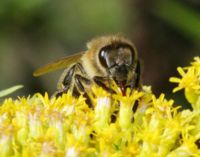
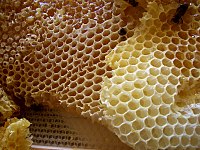




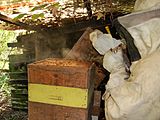






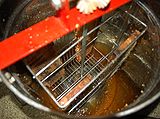


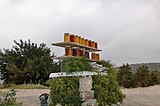
No comments:
Post a Comment